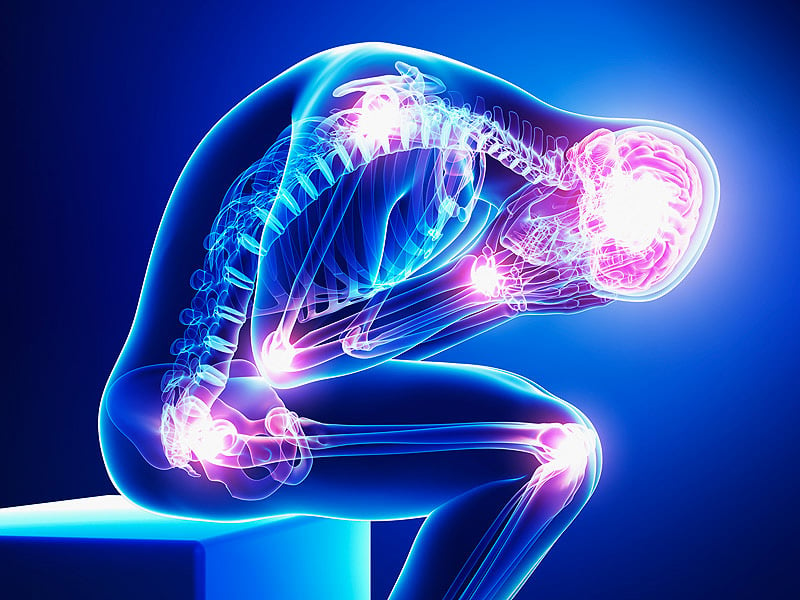What is Chronic Pain?

Chronic pain is pain that lasts longer than expected (for example, after recovery from an illness or injury).
Acute pain is caused by tissue damage, overload, inflammation or disease. Depending on the disease or condition, the pain can last for a long time. After the cause is stopped, treated or cured, the pain disappears again. Do you still have pain without an obvious cause, or do you have more pain than expected? We call that chronic pain.
Chronic pain is annoying, but not dangerous. Pain can have a lot of influence on your life, how you feel and what you can do. Both at home and at work.
People also read: Is it possible to treat Anxiety disorder?
How does chronic pain develop?
We don’t know how chronic pain develops. The fact that you are in pain is most likely due to how your body, thoughts, and environment react to the pain. These are referred to as physical, psychological, and social factors.
These factors affect how you feel pain and how you deal with it.
How does your body respond to the pain?
- If you have pain for a long time (for example due to a wound or inflammation), your nerves can become extra sensitive. The nerves then send extra pain stimuli to your brain. As a result, the pain you experience becomes more intense, lasts longer or expands. Even touching or moving can hurt.
- Sometimes your nerves remain hypersensitive, even though there is no longer an obvious cause for the pain. The nerves continue to send pain signals to your brain, even though the cause (for example, a wound or inflammation) has been treated and healed. That explains why the pain is sometimes worse or lasts longer than expected.
What thoughts and feelings do you have about the pain?

What you think and feel affects how you experience the pain and how you deal with it.
- If you think the pain is harmful or indicates a serious illness, it can make you insecure, anxious and depressed. As a result, you may avoid certain activities and activities.
- Anxiety, restlessness, tension, insecurity, loneliness, sadness and boredom can aggravate and maintain the pain. See: Xanax for anxiety
- Doom-mongering, worrying, endless worrying, and a sense of helplessness can exacerbate and perpetuate the pain.
People also read: Living with a Nightmare
How does your environment respond to the pain?
- If people around you are very concerned, it can amplify your own fear and pain.
- Sometimes your environment will take care of you and you will have to do less yourself. That can be nice, but sometimes it stops you from taking up activities yourself.
- Attention, acknowledgment, understanding, reassurance, distraction, relaxation, security and trust can reduce pain. This often makes it easier to pick up activities yourself.
Advice for chronic pain

- Try to find out what the pain means to you. Your GP will help you with this. Knowing that the pain doesn’t mean your body is being damaged can take the worry out of the pain. Often it is then possible to look at the pain in a different way. Remember that the pain is not dangerous. And that it makes little sense to keep looking for a cause.
- If you feel gloomy, anxious, or frustrated about the pain, it can make the pain worse. It can help to talk about these feelings. Also discuss it with your doctor. If necessary, a psychologist can support you in this.
- If people around you are worried, explain to them that your symptoms can be annoying or severe, but they are not of a serious cause. If people at home and at work know this, they are less concerned and you are less tense yourself. Support from family members, employers, or company doctors can help enormously.
- Are your complaints causing problems at work? In that case, discuss it with your employer and contact the company doctor. Adjustments at work can help reduce the pain.
- A healthy lifestyle with sufficient distraction, exercise and relaxation can help with the pain and reduce the need for painkillers. Exercise is good, unless it makes the pain much worse.
- Provide exercise and activities throughout the day. Are there any activities, activities or movements that you no longer do because of the pain? Then discuss it with your doctor. If necessary, a physiotherapist or rehabilitation doctor can guide you in this.
Medications for chronic pain

Are you unable to move, work or sleep properly because of the pain? Then you can use a painkiller.
- paracetamol is a very good pain reliever with few or no side effects.
- Paracetamol is therefore recommended as the first choice.
- Paracetamol works within half to 2 hours after taking it.
- If the pain returns, take the painkiller at fixed times, no more than 2 to 3 times a day 2 tablets of 500 milligrams (=mg). (Or 1 tablet of 500 mg paracetamol 3 to 6 times a day).
- For short-term pain, adults can take 2 tablets of 500 mg paracetamol up to 4 times a day (no longer than 4 weeks in a row).
- With prolonged use (longer than 4 weeks) you should not take 2 tablets of 500 mg paracetamol more than 2 times a day.
(Or 1 tablet of 500 mg paracetamol 5 times a day). - Instead of tablets, an adult can use a suppository of 1000 mg paracetamol (in the anus) 3 to 4 times a day. This works slower than swallowing tablets.
- You can buy paracetamol without a prescription at the pharmacy, drugstore or supermarket.
Always read the package leaflet first to see whether the painkiller is suitable for you, for example, whether it is combined with your other medicines or with a disease you have.
If paracetamol in that amount does not help, there are other pain relievers (NSAIDs) such as naproxen ,ibuprofen or diclofenac .
Note: NSAIDs can be bought without a prescription. That is not to say that they are suitable and safe for everyone.
Are you older than 60 years? Do you have stomach, intestinal, heart, vascular, or kidney problems? Do you use medicines? Or have you ever had an allergic reaction to an NSAID? Always consult your doctor before using an NSAID. For risks and side effects, look at NSAIDs.
Stronger Painkillers
Do you have severe chronic pain that prevents you from doing anything? Where the mentioned advice and medicines do not help enough? Sometimes your GP can (temporarily) prescribe a stronger painkiller (Opioids), for example, OxyContin or Roxicodone. You can only get these medicines with a prescription.
Oxycodone and morphine have side effects and can be addictive. That is why your GP only prescribes them in exceptional cases for chronic pain: in the lowest effective dose and for the shortest possible time.
Every 1-2 weeks you will visit your doctor for a check-up to discuss how things are going. As soon as possible, you gradually reduce the strong painkiller. Then the risk of side effects and addiction is smaller. Do you already have or have you had trouble quitting smoking or alcohol, for example? Or do you suffer from anxiety or depression? Then it is better not to use morphine-like painkillers.
Cannabis
Doctors do not recommend cannabis use for chronic pain. Too little research has been done into the effects and safety of cannabis. There is too little evidence that cannabis reduces pain or improves the quality of life. While there are many (sometimes serious) side effects.
Do you have severe and long-lasting pain from a very serious illness, such as cancer, have you tried all the pain medicines and do they not help you or do you not tolerate the side effects? Then you can discuss with your doctor whether you could try cannabis on prescription. Sometimes doctors prescribe Cannabis Strains such as Gelato, Blue Dream, etc., when no other pain treatment is possible.
Psychological help

Together with a psychologist or the GGZ practice nurse (POH-GGZ), you can see how you and those around you react to the pain. Does the pain evoke thoughts and feelings in you that amplify the pain? Is your environment very concerning?
In a number of conversations, you will see how the pain may be maintained.
You will also learn to look at your pain in a different way and to deal with it in a different way. This is called cognitive behavioral therapy.
In conversations and exercises, you learn to absorb or accept the pain and additional worries or fears better. You can also get help if you feel anxious, gloomy or powerless.
What about chronic pain? The way forward.
The GP will look at your needs and make a plan together with you.
You agree with your doctor about which painkillers you can use and when you come for a check-up. It is important to regularly check whether the advice and treatment are working sufficiently.
If all goes well, you will see together whether you can gradually reduce the painkillers again.
Sometimes the GP will refer to other care providers to assess which care and treatment(s) are best for you. For example, the help of a psychologist, physiotherapist, anesthesiologist and/or rehabilitation doctor from a pain treatment center.
When should you get help for chronic pain?

Contact your doctor:
- if you feel you are in too much pain;
- if the pain increases;
- if the painkillers cause too many side effects;
- if you can handle much less in everyday life;
- if you are unable to exercise regularly;
- if the pain makes you feel gloomy, anxious or powerless;
- if you develop any other pain or other symptoms of illness.
